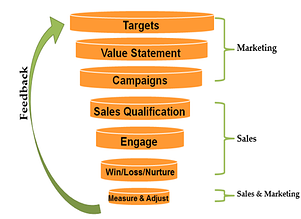Getting Sales to Engage with Marketing in the age of Inbound Marketing
We’ve written previously about the disconnect between marketing and sales. Here, from a sales perspective, we’ll look at some of these same pitfalls of working in silos and ways to overcome them.
Editor’s note: This blog was updated in April 2021 for accuracy and comprehensiveness.
It’s the age of online content and inbound marketing: OEMs and their suppliers and other industrial vendors are deploying much more content through a wide variety of digital media than ever before: webinars, videos, online demos, social media posts, live stream events. And that’s on top of more traditional offerings like blogs, ebooks, and infographics.
Prospects expect the ability to independently find detailed information about products, decision points, and applications. These days you can’t just post pictures of your equipment and tell visitors you’re an industry leader. You must also show it with written, visual, and video content that demonstrates your expertise in the prospect’s industry, specific business challenges, and the competition.
The flip side of this expectation is that sales reps should expect prospects to be aware of their products and services as well as the technologies behind their solutions. Reps should also expect them to be familiar with competitor offerings.
So in practice, what do you do when they already know so much of what you were going to pitch them?
Prospects expect sales reps to be knowledgeable beyond the content they’ve already consumed on their own. That is, reps need to be well versed in industry trends and what keeps decision makers up at night.
No longer can sales rely on talking benefits and features. You must show that you really understand what they’re up against. They want to get to the heart of the matter – “tell me what you can do for me” – and it’s not about the product.
The ever-increasing availability of content means they already know, or can find, information about the product. By the time they interact with sales, they are ready for the next level, such as:
Adding to the challenge for sales is our experience as retail consumers: the trend toward personalization and customization in the C2C space is having an impact on B2B expectations too. Prospects value when reps understand the nuances of their needs.
For example, suppose a prospect manufactures medical devices that are used in field hospitals in harsh, remote locations. If you sell the raw materials they use in the devices, you must understand that quality control of those raw materials is critical to the devices’ surviving the conditions they’re used in. Therefore, that is a higher priority than lead time or even pricing because their customers can’t use the product if it breaks in their environment.
Staying in sync throughout the funnel
Where does this leave us? Reps need to learn as much as possible about their prospects and customers in order to answer those next-level questions and address unique needs.
At each point in the sales cycle information is gathered about prospects that will be helpful at later stages. We can use an online sales and marketing platform to keep track of all of this marketing, sales, and customer service data in a single place so everyone involved in the sales cycle can add and review all of the information to leverage as needed.
What kind of information are we talking about? Almost every interaction with website visitors, prospects, and customers can be tracked and later analyzed with a shared platform for greater visibility into the sales cycle, such as:
Of course, sales should also keep an eye on trade publications, industry events, vendor webinars, and how direct competitors are reaching out to prospects. It all adds context to the sales cycle.
At Acadia, we can get you set up with a user friendly platform that still meets your needs for sophisticated marketing and sales functionality. Please get in touch so we can talk about your sales cycle, challenges, and goals!
Comments